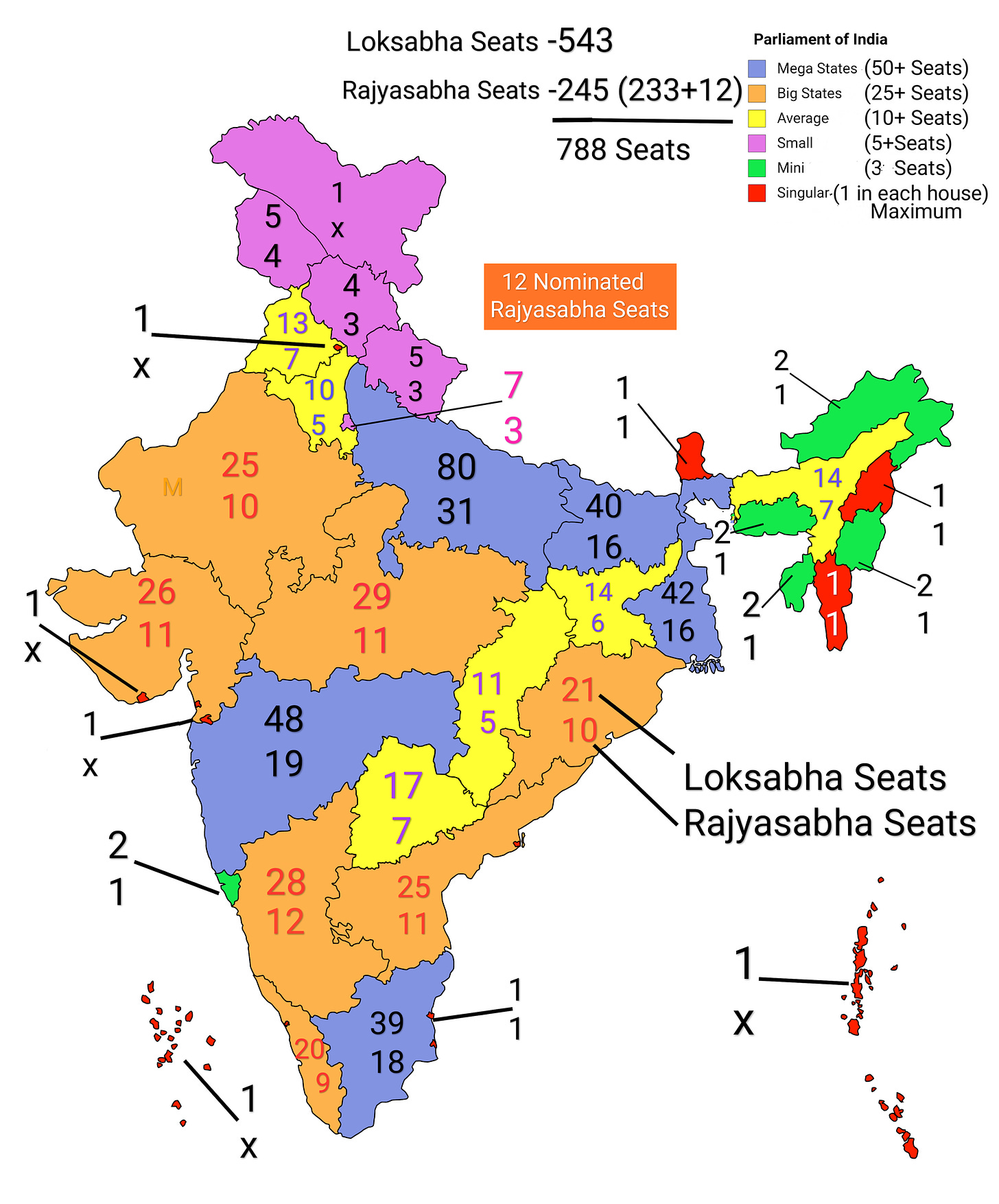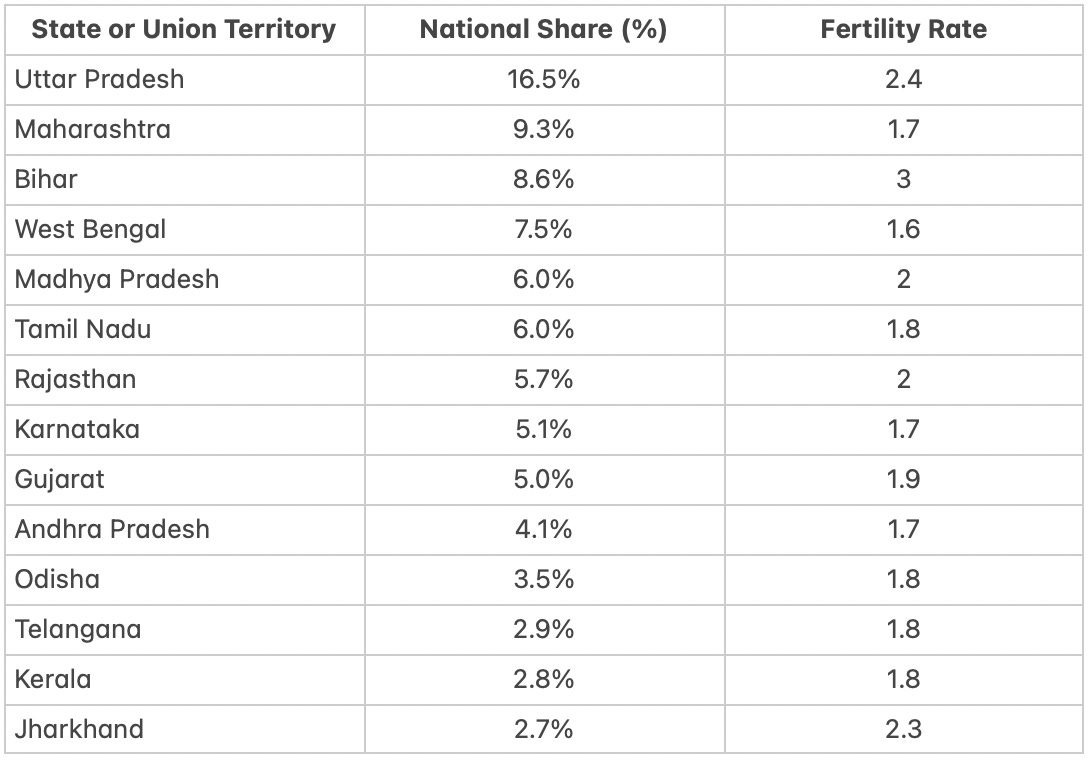We make a big deal about elections in every country where elections are held. Who are we electing?
Representative forms of government across the world need to determine who or rather how many people will the representatives be allowed to represent. For this purpose, in India, we divide places into districts and the population in each district votes to elect the representatives fighting for those districts.
At the time of Independence India had a population of 340 million.
The Lok Sabha was created with 494 seats to represent this population. Each representative would represent not more than 850,000 people. This was meant to ensure that if a region was lightly populated they do not end up with outsized influence in political decision-making. With the states reorganisations act of 1956, this was increased to 522 and was last increased to the current 543 in 1973. Indian population at the time was 596 million.
Since then Indian population has ballooned 2.3 times and today we have a situation where certain members of Parliament have over 1.6 million constituents. This creates a situation where several people do not find adequate representation.
Delimitation is the process of redrawing boundaries of parliamentary or assembly constituencies. The idea is to allot seats, in other words have representatives, based on the population. Ideally, each representative — a member of the Parliament or the state legislature — is supposed to represent an equal number of the population in the house. To achieve this, the Constitution requires that the delimitation is done after a Census (an official count of a population arrived at through a survey).
[…]
After the delimitation in 1972-73, the process had been suspended twice for 25 years in 1976 and in 2001. A delimitation exercise undertaken in 2001 did redraw the borders of several constituencies in order to bring about a certain amount of equality in population in each constituency. However, the number of constituencies that each state had did not change. The constituency borders have been frozen since then until the first census after 2026, or at least until after 2031.
Source: CNBC
The new parliament that was recently inaugurated has 1272 seats in the Lok Sabha to accommodate for this demographic shift that has taken place.
But here is where the troubles begin.
In the intervening 50 years, the demographics of the nation have significantly changed.

Source: Wikipedia
No central government has ever been able to ignore Uttar Pradesh, which represents 80 seats in the Lok Sabha. Between Gujarat, Rajasthan, Madhya Pradesh, Uttar Pradesh and Bihar, 200 out of 543 seats are represented.
Even so, the South, Kerala, Andhra Pradesh, Telangana, Karnataka and Tamil Nadu combined account for 129 seats. Include Maharashtra on that list and it represents almost 50% of India’s GDP. Including the 48 seats in Maharashtra, the total comes to 177.

Source: Wikipedia
Let us just take the case of Uttar Pradesh.
In the 2011 census, the state had a population of ~200 million. If a region has a fertility rate of 2.1, it is said to have a replacement rate. With a fertility rate of 2.4, the state would have grown by ~20% or it should have a population of close to 240 million.
At 850,000 constituents per seat, this would result in Uttar Pradesh alone having ~ 282 seats. Even at 1200 seats total, it would imply that one state would have ~ 25% of the seats in Lok Sabha.
Not to mention, Madhya Pradesh, Jharkhand, Rajasthan, Uttar Pradesh and Bihar are the only states with fertility rates at or above 2.
Leaders of southern states have raised their concerns, stating that the northern states whose population growth rates have been higher than theirs would go on to benefit from a delimitation exercise whereas southern states which have followed the Centre’s norms on population control would be penalised.
KT Rama Rao, IT Minister of Telangana and working president of the state’s ruling party BRS, has called all leaders of political parties of southern states to join the fight against the delimitation as these states comprising 18 per cent of the country’s population contribute 35 per cent of the GDP. With delimitation, these states would be put at a disadvantage.
Source: CNBC
The gap between the North and the South is widening in terms of population. Fertility is much higher in the North. At the same time, there is a skew in economic output skewed towards the South. The population of the southern states is ageing, declining and more affluent; whereas the population of the northern states are younger, growing and poorer.
The delimitation is an Act of government which cannot be challenged in the courts. The Southern states are going to vehemently oppose this exercise. It is going to become a political hot potato. The ruling party is going to want to ram this through because it will ensure future election victories.
For the South, secession is the only card that they hold. But it would be challenging to push that idea through.

Leave a Reply